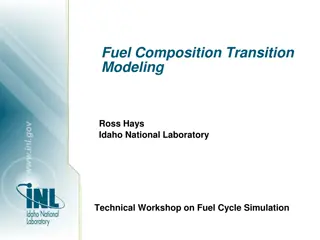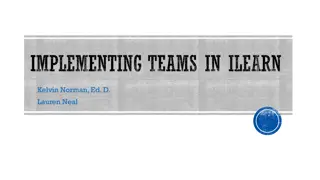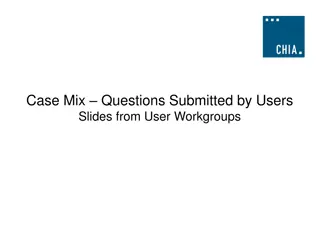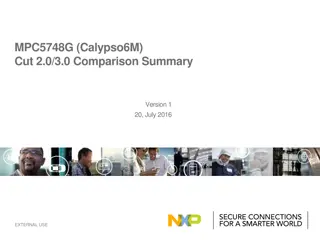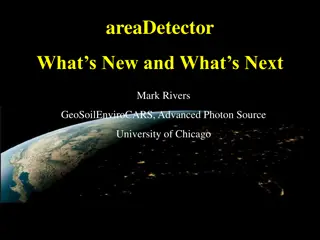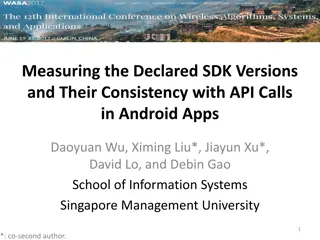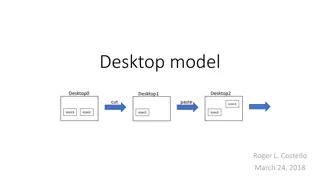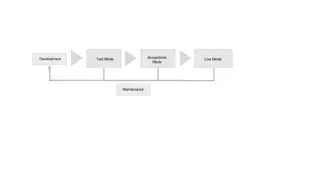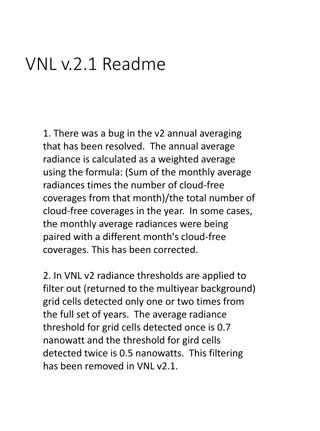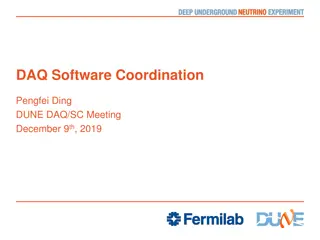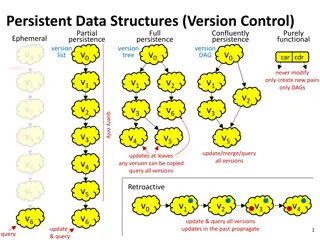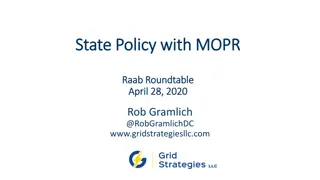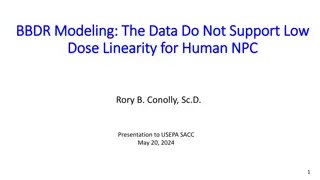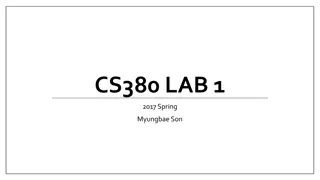Overview of Army Modeling and Simulation Office
The U.S. Army Modeling and Simulation Office (AMSO) serves as the lead activity in developing strategy and policy for the Army Modeling and Simulation Enterprise. It focuses on effective governance, resource management, coordination across various community areas, and training the Army Analysis, Mod
1 views • 8 slides
Capacity Zone Modeling for Forward Capacity Auction 17 Results
This presentation unveils the Capacity Zone modeling calculations for Forward Capacity Auction 17 associated with the 2026-2027 Capacity Commitment Period by ISO-NE PUBLIC. It delves into boundary definitions, import-constrained zone modeling, and market rules guiding the assessments and modeling pr
0 views • 16 slides
Distribution Feeder Modeling and Analysis Overview
This document delves into the modeling, optimization, and simulation of power distribution systems, specifically focusing on Distribution Feeder Modeling and Analysis. It covers the components of a typical distribution feeder, series components, Wye-Connected Voltage Regulator modeling, and equation
0 views • 14 slides
Understanding Data Modeling vs Object Modeling
Data modeling involves exploring data-oriented structures, identifying entity types, and assigning attributes similar to class modeling in object-oriented development. Object models should not be solely based on existing data schemas due to impedance mismatches between object and relational paradigm
0 views • 17 slides
Evolution of Modeling Methodologies in Telecommunication Standards
Workshop on joint efforts between IEEE 802 and ITU-T Study Group 15 focused on information modeling, data modeling, and system control in the realm of transport systems and equipment. The mandate covers technology architecture, function management, and modeling methodologies like UML to YANG generat
1 views • 16 slides
Understanding Geometric Modeling in CAD
Geometric modeling in computer-aided design (CAD) is crucially done in three key ways: wireframe modeling, surface modeling, and solid modeling. Wireframe modeling represents objects by their edges, whereas surface modeling uses surfaces, vertices, and edges to construct components like a box. Each
1 views • 37 slides
Mathematical Modeling and Error Analysis in Engineering
Mathematical modeling plays a crucial role in solving engineering problems efficiently. Numerical methods are powerful tools essential for problem-solving and learning. This chapter explores the importance of studying numerical methods, the concept of mathematical modeling, and the evaluation proces
0 views • 10 slides
Introduction to Dynamic Structural Equation Modeling for Intensive Longitudinal Data
Dynamic Structural Equation Modeling (DSEM) is a powerful analytical tool used to analyze intensive longitudinal data, combining multilevel modeling, time series modeling, structural equation modeling, and time-varying effects modeling. By modeling correlations and changes over time at both individu
0 views • 22 slides
System Modeling and Simulation Overview
This content provides insights into CPSC 531: System Modeling and Simulation course, covering topics such as performance evaluation, simulation modeling, and terminology in system modeling. It emphasizes the importance of developing simulation programs, advantages of simulation, and key concepts lik
0 views • 28 slides
Understanding Object Modeling in Software Development
Object modeling is a crucial concept in software development, capturing the static structure of a system by depicting objects, their relationships, attributes, and operations. This modeling method aids in demonstrating systems to stakeholders and promotes a deeper understanding of real-world entitie
1 views • 65 slides
Coupled Ocean-Atmosphere Modeling on Icosahedral Grids
Coupled ocean-atmosphere modeling on horizontally icosahedral and vertically hybrid-isentropic/isopycnic grids is a cutting-edge approach to modeling climate variability. The design goals aim to achieve a global domain with no grid mismatch at the ocean-atmosphere interface, with key indicators such
1 views • 21 slides
Fuel Composition Transition Modeling in Two-Stage Recycling Reactors
Modeling the transition of fuel composition in a two-stage recycling reactor scenario poses a unique challenge that previous versions of VISION were unable to address. By tracking fuel mass and isotopics through various stages of the fuel cycle, VISION now enables the modeling of reactors with recip
0 views • 15 slides
Fire and Smoke Modeling Evaluation Effort (FASMEE) Overview
FASMEE is a collaborative project aimed at assessing and advancing fire and smoke modeling systems through critical measurement techniques and observational data. Led by key technical leads, FASMEE focuses on diverse modeling areas such as fire growth, effects, coupled fire-atmosphere behavior, smok
5 views • 30 slides
Maximizing Your Microsoft Teams Experience: Web vs Desktop Versions, Features, and Installation Guide
Explore the benefits and features of Microsoft Teams Web and Desktop versions, learn how to access and install Teams, understand the distinctions between the two versions, and discover common features like chatting, video calls, screen sharing, breakout rooms, and more.
0 views • 31 slides
Subarea and Highway Corridor Studies: Travel Demand Modeling and Refinements
In this lesson, we delve into subarea and corridor studies focusing on travel demand model refinements, highway network coding, corridor congestion relief, and trip assignment theory. Subarea modeling plays a crucial role in forecasting travel within smaller regions with detailed traffic patterns, t
1 views • 45 slides
Evolution of DRG Versions in Massachusetts Inpatient Data
This presentation delves into the history and evolution of Diagnosis Related Group (DRG) versions in Massachusetts Inpatient Hospital Discharge Data (HDD) from 2001 to 2013. It explores the different DRG versions available, such as VHAF-DRG, AP-DRG, APR-DRG, and CMS-DRG, detailing the changes and en
0 views • 25 slides
Essential Steps for Setting up a Modeling Study
Ensure clarity on modeling goals and uncertainties. Select sample areas strategically based on interest and available data. Determine appropriate resolution for modeling. Define variables to model and validate the model effectively. Assess sample data adequacy and predictor variables availability. E
0 views • 9 slides
Water Storage Tanks Hydraulic Modeling and Water Quality Considerations
This presentation by Justine Carroll, P.E., Project Manager, focuses on the hydraulic modeling and water quality considerations related to water storage tanks. It covers topics such as water age evaluation, steady state modeling, extended period simulations, pump controls, demand patterns, EPS verif
0 views • 34 slides
Advancing Computational Modeling for National Security and Climate Missions
Irina Tezaur leads the Quantitative Modeling & Analysis Department, focusing on computational modeling and simulation of complex multi-scale, multi-physics problems. Her work benefits DOE nuclear weapons, national security, and climate missions. By employing innovative techniques like model order re
0 views • 6 slides
Flexible Framework for Stormwater Lids Modeling
A new flexible framework for forward and inverse modeling of stormwater lids is presented. It includes governing equations, hydraulic and contaminant transport, numerical methods, and demonstration cases for various green infrastructure components. The importance of different processes in modeling i
0 views • 20 slides
MPC5748G Cut 2.0/3.0 Errata Summary Comparison
This presentation compares the errata summary between MPC5748G cut 2.0 and cut 3.0 versions. It highlights various discrepancies and issues identified in both versions, ranging from potential sequencing issues to pad control problems. The comparison sheds light on the differences in erratum across t
0 views • 14 slides
Latest Updates on areaDetector: Releases, Features, and Enhancements
The latest developments in areaDetector by Mark Rivers at the University of Chicago include updates on releases, major features in versions 3-2 and 3-3, as well as upcoming plans for versions 4-0 and 5-0. Key points cover EPICS_NTNDA_Viewer for ImageJ plugin, advantages of NTNDArray data transmissio
0 views • 18 slides
Sustainability and Organic Livestock Modeling for Global Food Security
The research presented at the 18th Organic World Congress in Istanbul delves into the Sustainability and Organic Livestock (SOL-m) modeling approach developed by FAO and FiBL. The study aims to explore the potential impacts of global conversion to organic livestock production by 2050 on food securit
0 views • 25 slides
Understanding Automated Speech Recognition Technologies
Explore the world of Automated Speech Recognition (ASR), including setup, basics, observations, preprocessing, language modeling, acoustic modeling, and Hidden Markov Models. Learn about the process of converting speech signals into transcriptions, the importance of language modeling in ASR accuracy
0 views • 28 slides
Guide to Registering for GAINS Model Training Session and Accessing GAINS Versions
Learn how to register for the GAINS-SPIPA Training Session on April 12, 2021, and gain access to the GAINS Model. Follow the steps for registration, confirmation, activation, and accessing different versions of the model. Ensure access to the private and public GAINS versions with the right credenti
0 views • 9 slides
Overview of ALICE ITS UPGRADE System Scrubbing and FPGA Programming
ALICE ITS UPGRADE system undergoes scrubbing for error correction using various techniques like Xilinx Soft Error Mitigation Core and External Scrubbing Network. The FPGA programming overview includes standard operations, remote updating methods, and FPGA versions timeline. Relevant topics cover dat
0 views • 19 slides
Update on Modeling and Coordination Discussions
Weekly coordination calls with Ramboll and discussions with EPA OAQPS leads focused on Regional Haze and modeling adjustments. Final draft of procedures document with visibility projections and glide slope adjustments. Upcoming RTOWG meetings covering methodology, projections, and modeling evaluatio
0 views • 5 slides
Importance of Data Modeling in Industrial Information Systems
Introduction to data modeling and design in Industrial Information Systems at King Saud University College of Engineering. The chapter covers the significance of data modeling, capturing data characteristics, structural information, and the role of databases and DBMS. Data modeling fills crucial gap
0 views • 51 slides
Analyzing Declared SDK Versions' Consistency with API Calls in Android Apps
Understanding the importance of Declared SDK (DSDK) versions in Android apps and their impact on API calls. Exploring the potential side effects of incorrect SDK version declarations and the need for developers to adhere to proper SDK versioning practices for compatibility and security. Delve into e
1 views • 24 slides
Mega-Modeling for Big Data Analytics
Mega-Modeling is a comprehensive approach that encompasses model construction, evaluation, composition, evolution, and search to address challenges in various areas such as social and economic resilience, health, transportation, and energy management. The pillars of Mega-Modeling include Model-Drive
0 views • 14 slides
Modeling Desktops and Software Operations
Explore the process of modeling desktops and software operations, including adding, removing, cutting, and pasting icons. Learn about creating versions of models with hardcoded icons or arbitrary sets. Dive into the ordering of desktops and the utilization of icons A and B in the model.
0 views • 18 slides
Development Lifecycle Overview - Roles, Systems, and Revisions
Explore the comprehensive development lifecycle encompassing acceptance mode, test mode, live mode, and maintenance. Dive into roles and organization structures, application versions, project resources, connectors, and system configurations. Witness the evolution of live and acceptance versions, alo
0 views • 4 slides
Enhancements and Fixes in VNL Version 2.1 and 2.2
This readme document outlines the bug fixes and improvements implemented in VNL versions 2.1 and 2.2. In version 2.1, a bug affecting the annual averaging process was resolved, ensuring accurate calculation of annual average radiance. Additionally, radiance thresholds applied in previous versions fo
0 views • 5 slides
Desired Features of a Software Build System for DUNE DAQ
Discussion on the desired features of a software build system for DUNE DAQ, including creating C++ builds, supporting multiple languages, handling multiple software versions, efficient change management, easy installation processes, modularity, and more. The aim is to streamline the software develop
0 views • 9 slides
NetLogo - Programmable Modeling Environment for Simulating Natural and Social Phenomena
NetLogo is a powerful and versatile programmable modeling environment created by Uri Wilensky in 1999. It allows users to simulate natural and social phenomena by giving instructions to multiple agents operating independently, making it ideal for modeling complex systems evolving over time. NetLogo
0 views • 7 slides
Understanding Persistent Data Structures and Version Control
Exploring persistent data structures and version control concepts, including partial persistence, full confluence, purely functional approaches, and ephemeral versions. Delve into tree lists, full and partial persistence, query methods, retroactive updates, planar point location, path copying in tre
0 views • 9 slides
Understanding the Impacts of State Policy with MOPR Versions on Clean Energy
Grid Strategies estimate a significant impact of MOPR versions on clean energy, with the latest version 10.0 raising costs and potentially reducing clean energy adoption. Various MOPR versions lack a coherent consensus theory, influencing demand response, utility self-supply, energy efficiency, and
0 views • 10 slides
Analysis of BBDR Modeling for Human NPC Dose Linearity
The BBDR modeling for human NPC dose linearity is examined through various studies and updates from 2003 to 2024. Key aspects include formaldehyde BBDR, regulatory acceptance/rejection, EPA/IRIS concerns, and the 2023 BBDR model update addressing main issues. The 2023 BBDR model presents two version
0 views • 10 slides
Reservoir Modeling Using Gaussian Mixture Models
In the field of reservoir modeling, Gaussian mixture models offer a powerful approach to estimating rock properties such as porosity, sand/clay content, and saturations using seismic data. This analytical solution of the Bayesian linear inverse problem provides insights into modeling reservoir prope
0 views • 10 slides
Modern OpenGL Programming Lab Overview
This is an overview of a lab in the field of modern OpenGL programming, focusing on versions 2.x and under as well as versions 3.x and above. The content covers setting up environments, working with different OpenGL versions, utilizing GLUT for platform independence, and more. It provides guidance f
0 views • 50 slides











